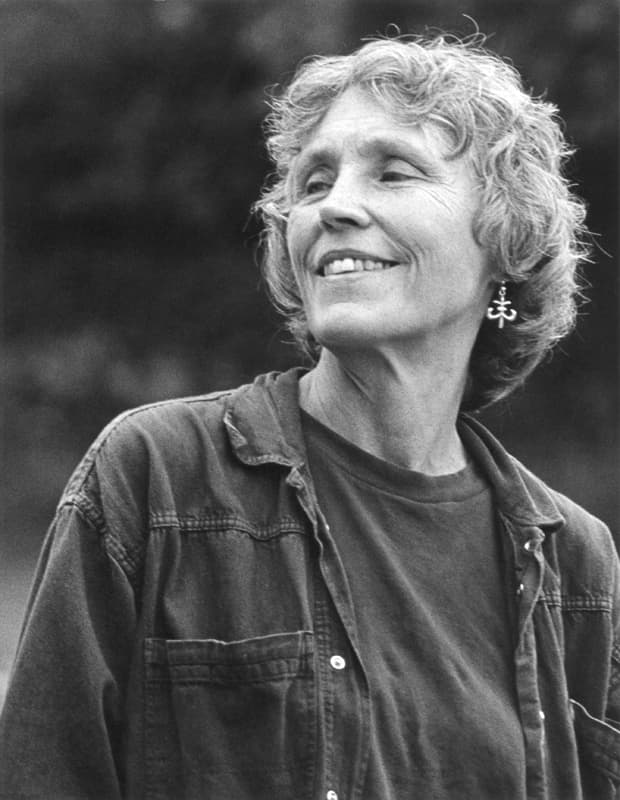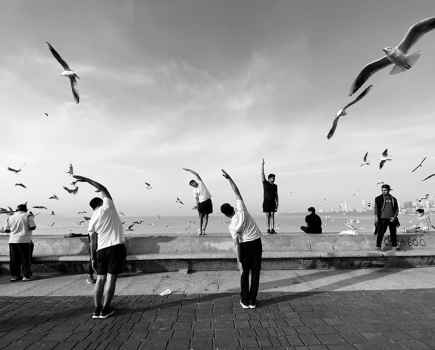© Evald Larsen
Fay Godwin is famed as much for her creative interpretations of the landscape as for her campaigning to conserve it. Her work ranged from atmospheric studies of prehistoric sites to images of refuse-strewn and polluted rivers. It is, by turns, a celebration of the British countryside, a lament for what has been lost and a warning about what will happen if action is not taken to preserve it.
Surprisingly, Godwin didn’t start taking photographs until she was in her mid-30s, while married to Tony Godwin, then editor-in-chief of Penguin Books. She began by shooting snapshots of her two young children and soon discovered a great passion for photography. She taught herself to develop and print, and after she and her husband separated in 1969, she decided to become a professional photographer.
Through her publishing connections she began photographing writers, primarily for use as publicity material. She photographed many major literary figures in Britain at the time, including Ted Hughes, Philip Larkin, Seamus Heaney and Doris Lessing. Shot in natural light and often using the writers’ homes as their background, these images are understated and perceptive portraits.
Godwin’s estranged husband died suddenly in 1976 and at around the same time she herself was diagnosed with cancer. Godwin recovered, but afterwards the direction of her work began to change. ‘After being ill, I concentrated more on the landscape. In a sense, all the natural things became incredibly important,’ she said in an interview for ITV’s The South Bank Show in 1986.
Her first book, The Oldest Road: An Exploration of the Ridgeway (1975), co-authored with John Richard Lane Anderson, featured the landscapes of the North Wessex Downs and the Chilterns, often focusing on ancient features in the landscape, such as the Neolithic stone circles at Avebury and the prehistoric White Horse at Uffington.
In 1978 she received a major award from the Arts Council of Great Britain, which allowed her to continue and develop her landscape photography. More books followed, including Remains of Elmet (1979), which she co-authored with poet Ted Hughes. This book, with its often dark and dramatic interpretations of the Pennine landscape, was especially important in establishing her reputation.
 Image: Paved path above Lumbutts, near Todmorden, West Yorkshire (from Remains of Elmet, 1979) © COLLECTIONS, LONDON
Image: Paved path above Lumbutts, near Todmorden, West Yorkshire (from Remains of Elmet, 1979) © COLLECTIONS, LONDON
Godwin disliked purely picturesque views of the landscape and her work was never sentimental. ‘I’ve been called a Romantic photographer and I hate it,’ she said. ‘It sounds slushy and my work is not slushy. I’m a documentary photographer, my work is about reality, but that shouldn’t mean I can’t be creative.’
During this period she worked in black & white, using medium-format equipment, and her images were noted for their clarity, careful composition and expert control over tonal values. She was known for great tenacity and determination when creating an image. When someone once remarked to her that she had been lucky to catch the ideal cloud formations in a particular picture she quickly replied, ‘I didn’t “catch” it. I sat down and waited three days for it.’
Her book Land, published in 1985, was the summation of her work in that period. It was a critical and commercial success. It showed Britain as a place of standing stones, ruined castles and industrial relics, a mysterious land of breathtaking vistas, moody skies and sometimes desolate and threatening landscapes.
However, Godwin was also determined to show how the British countryside was changing for the worse. This aspect of her work came to the fore in her next book, Our Forbidden Land (1990). It showed how large areas of countryside were being torn up for development, how pollution was affecting rivers and forests, and the ways in which public rights of access to land was being denied by landowners.
Godwin’s work was changing in other ways as she looked for new challenges. After being awarded a Fellowship of the National Museum of Photography in 1986, she spent a year working on a series of colour industrial landscapes, shot in and around Bradford, West Yorkshire.
This work was later followed by a series of colour abstract images focusing on shape, texture and form in still-life setups of foliage. Godwin was unable to find a publisher for the latter project and it was eventually privately published under the title Glassworks & Secret Lives (1998).
 Image: ‘Leaping Lurcher’ (from Rebecca the Lurcher, 1973) © COLLECTIONS, LONDON
Image: ‘Leaping Lurcher’ (from Rebecca the Lurcher, 1973) © COLLECTIONS, LONDON
By this time, Godwin was unable to walk distances due to what she described as ‘NHS drugs with adverse effects that wrecked my heart.’ She sold her darkroom equipment and enthusiastically adopted digital photography. However, after one final book, the career retrospective Landmark (2001) and the accompanying major exhibition at London’s Barbican Gallery, her health declined further. She died in 2005.
Godwin’s exceptional body of work, her outspoken personality and her genuine concern for the environment made her a unique figure in British photography. Her unpretentious attitude to photography and her devotion to the landscape are captured in this quote from one of her final interviews, with journalist David Corfield in 2004:
‘I don’t get wrapped up in technique and the like,’ she said. ‘I have a simple rule and that is to spend as much time in the location as possible. You can’t expect to take a definitive image in half an hour. It takes days, often years. And in fact I don’t believe there is such a thing as a definitive picture of something. The land is a living, breathing thing and light changes its character every second of every day. That’s why I love it so much.’
Biography
- 1931 Born Fay Simmonds, in Berlin, Germany, on 17 February. Her father is a British diplomat and her mother an American artist
- 1958 After attending nine schools, she settles in London and begins working in publishing
- 1961 Marries Anthony Godwin, editor-in-chief of Penguin Books
- 1966 Begins taking family pictures and becomes deeply interested in photography
- 1975 Her first book, The Oldest Road (co-authored with John Richard Lane Anderson) is published
- 1978 Receives a major award from the Arts Council of Great Britain
- 1985 Publishes Land, a collection of her work to date. It is a critical and commercial success
- 1986 Becomes the first photographer to be featured as a subject on TV’s The South Bank Show
- 1987-90 Serves as president of the Ramblers’ Association
- 1990 Publishes Our Forbidden Land, which wins the first Green Book of the Year Award
- 2001 Last major retrospective of Godwin’s work is held at London’s Barbican Gallery
- 2005 Dies on 27 May in Hastings, East Sussex, aged 74
Books
Landmarks: Photographs by Fay Godwin, published by Dewi Lewis, contains a wide range of her work, including landscapes, portraits and abstracts. Many of the other 16 books Godwin authored or co-authored are available second-hand on www.amazon.co.uk.






